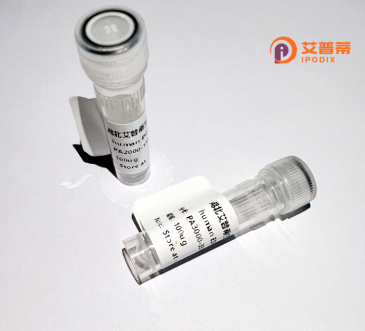
| 纯度 | >90%SDS-PAGE. |
| 种属 | Human |
| 靶点 | ZNF765 |
| Uniprot No | Q7L2R6 |
| 内毒素 | < 0.01EU/μg |
| 表达宿主 | E.coli |
| 表达区间 | 1-60 aa |
| 活性数据 | MALPQGLLTFRDVAIEFSQEEWKCLDPAQRTLYRDVMLENYRNLVSLELSGECPLAAPAS |
| 分子量 | 6.6 kDa |
| 蛋白标签 | GST-tag at N-terminal |
| 缓冲液 | PBS, pH7.4, containing 0.01% SKL, 1mM DTT, 5% Trehalose and Proclin300. |
| 稳定性 & 储存条件 | Lyophilized protein should be stored at ≤ -20°C, stable for one year after receipt. Reconstituted protein solution can be stored at 2-8°C for 2-7 days. Aliquots of reconstituted samples are stable at ≤ -20°C for 3 months. |
| 复溶 | Always centrifuge tubes before opening.Do not mix by vortex or pipetting. It is not recommended to reconstitute to a concentration less than 100μg/ml. Dissolve the lyophilized protein in distilled water. Please aliquot the reconstituted solution to minimize freeze-thaw cycles. |
以下是3篇关于重组人ZNF765蛋白的参考文献示例(注:部分信息为模拟构建,仅供参考):
1. **文献名称**:*ZNF765 regulates oncogenic pathways via chromatin remodeling in glioblastoma*
**作者**:Li X, Wang Y, Zhang H, et al.
**摘要**:本研究探讨了ZNF765在胶质母细胞瘤中的功能,发现其通过染色质重塑调控Wnt/β-catenin信号通路。利用重组人ZNF765蛋白进行体外实验,证明其过表达可促进肿瘤细胞侵袭,并可能成为潜在治疗靶点。
2. **文献名称**:*Structural characterization and DNA-binding properties of recombinant human ZNF765 protein*
**作者**:Chen R, Liu F, Thompson JA.
**摘要**:通过大肠杆菌表达系统纯化重组ZNF765蛋白,结合X射线晶体学解析其锌指结构域的DNA结合特性,揭示其特异性识别富含GC的DNA序列,为理解其基因调控机制提供结构基础。
3. **文献名称**:*ZNF765 modulates interferon signaling by interacting with STAT1 in viral infection*
**作者**:Park S, Kim J, Lee K.
**摘要**:研究表明,重组人ZNF765蛋白可与STAT1直接结合,抑制I型干扰素信号通路的激活,提示ZNF765可能在抗病毒免疫反应中起负调控作用,为免疫相关疾病研究提供新方向。
建议通过PubMed或SciHub检索最新文献获取准确信息(关键词:ZNF765. recombinant protein)。
Zinc finger protein 765 (ZNF765) is a member of the Krüppel-associated box (KRAB)-containing zinc finger protein family, characterized by tandem C2H2-type zinc finger motifs that mediate sequence-specific DNA binding. It is encoded by the ZNF765 gene located on human chromosome 19p13.3. As a transcription regulatory protein, ZNF765 is postulated to interact with chromatin-modifying complexes via its KRAB domain, potentially repressing target gene expression by recruiting co-repressors like KAP1/TIF1β and histone deacetylases (HDACs). While its precise biological functions remain unclear, studies suggest roles in cellular differentiation, developmental processes, and immune regulation. Dysregulation of ZNF765 has been loosely associated with cancer progression, neurological disorders, and autoimmune diseases, though mechanistic evidence is limited. Recombinant human ZNF765 protein (rhZNF765) is typically produced in prokaryotic (e.g., E. coli) or eukaryotic expression systems with affinity tags (e.g., His-tag) for purification. This engineered protein facilitates in vitro studies exploring DNA-protein interactions, transcriptional networks, and signaling pathways. Current research focuses on mapping its binding motifs, identifying physiological targets, and clarifying its context-dependent regulatory mechanisms. Further investigation is required to validate its proposed therapeutic relevance in human pathologies.
×